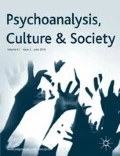Abstract
This article engages Lacanian and Kristevan psychoanalysis to examine lynching photographs and picture postcards that were disseminated throughout the southern United States between 1890 and 1940. I argue that these photographs are not only archival objects intended to incite racial terrorization and propagate white supremacy, but also unstable signifiers that expose the concerted méconnaissance of whiteness as wholeness. Introducing the concept of the abject stain, I indicate how lynching photographs inaugurate an unsettling encounter with the extimate horror of racial alterity, which is experienced as an intimate ethics of witnessing.







Similar content being viewed by others
Notes
My use of the term archivization and its relation to signification and temporality is influenced by Derrida’s (1995) Archive Fever, in which he declares that “the question of the archive is not, we repeat, a question of the past… It is a question of the future, the question of the future itself, the question of a response, of a promise and of a responsibility for tomorrow” (p. 36).
An overt example of racial terrorization through the use of language and image may be found in the 1902 picture postcard that, on the front, depicts the charred torso of an unidentified African American male and, on the reverse, bears the following message: “Warning. The answer of the Anglo-Saxon race to black brutes who would attack the womanhood of the South” (Allen, 2000, plates 59 and 60).
In Camera Lucida, Barthes (1980) describes the “subtle moment” when being photographed renders an individual “neither subject nor object but a subject who feels he is becoming an object” (p. 14). Not unlike the existential slippage that occurs underneath the camera’s eye, the lynched corpse, as an object of hatred and anxiety, signifies the fragile borders of subjectivity to the extent that the lifeless body is rendered “neither subject nor object,” but abject, which Kristeva (1980) views as a disturbing threshold of loss at the limits of subjectivity and otherness.
References
Allen, J. (2000) Without Sanctuary: Lynching Photography in America. Santa Fe: Twin Palms Publishers.
Barthes, R. (1980, 1981) Camera Lucida: Reflections on Photography. Translated by R. Howard. New York: Hill and Wang.
Brundage, W.F. (1993) Lynching in the New South: Georgia and Virginia, 1880–1930. Chicago: University of Illinois Press.
Derrida, J. (1995, 1996) Archive Fever: A Freudian Impression. Translated by E. Prenowitz. Chicago: The University of Chicago Press.
Fanon, F. (1952, 2008) Black Skin, White Masks. Translated by R. Philcox. New York: Grove Press.
Hale, G.E. (1999) Making Whiteness: The Culture of Segregation in the South, 1890-1940. New York: Vintage Books.
Kristeva, J. (1980, 1982) Powers of Horror: An Essay on Abjection. Translated by L.S. Roudiez. New York: Columbia University Press.
Kristeva, J. (1988, 1991) Strangers to Ourselves. Translated by L.S. Roudiez. New York: Columbia University Press.
Kristeva, J. (1997, 2002) Intimate Revolt: The Power and Limits of Psychoanalysis. Vol. 2. Translated by J. Herman. New York: Columbia University Press.
Kristeva, J. (2002) Revolt, She Said. Translated by B. O’Keeffe. Los Angeles: Semiotext(e).
Kristeva, J. (2005, 2010) Hatred and Forgiveness: The Power and Limits of Psychoanalysis. Vol. 3. Translated by J. Herman. New York: Columbia University Press.
Lacan, J. (1966, 1977) The mirror stage as formative of the function of the I as revealed in psychoanalytic experience. In: Écrits: A Selection. Translated by A. Sheridan. New York: W.W. Norton, pp. 1–7.
Lacan, J. (1973, 1998) The Seminar of Jacques Lacan, Book XI: The Four Fundamental Concepts of Psychoanalysis. Translated by A. Sheridan. New York: W.W. Norton.
Lacan, J. (1975a, 1988) The Seminar of Jacques Lacan, Book I: Freud’s Papers on Technique. Translated by J. Forrester. New York: W.W. Norton.
Lacan, J. (1975b, 1999) The Seminar of Jacques Lacan, Book XX: On Feminine Sexuality, The Limits of Love and Knowledge. Translated by B. Fink. New York: W.W. Norton.
Lacan, J. (1981, 1997) The Seminar of Jacques Lacan, Book III: The Psychoses. Translated by R. Grigg. New York: W.W. Norton.
Lacan, J. (1986, 1992) The Seminar of Jacques Lacan, Book VII: The Ethics of Psychoanalysis. Translated by D. Porter. New York: W.W. Norton.
Lacan, J. (1991, 2007) The Seminar of Jacques Lacan, Book XVII: The Other Side of Psychoanalysis. Translated by R. Grigg. New York: W.W. Norton.
Lacan, J. (2002, 2006) The instance of the letter in the unconscious, or reason since Freud. In: Écrits: The first complete edition in English. Translated by B. Fink. New York: W.W. Norton, pp. 412–441.
Miller, J.A. (2012) Suture (elements of the logic of the signifier). In: P. Hallward and K. Peden (eds.) Concept and Form, Volume 1: Key Texts from the Cahiers pour l’Analyse. Translated by J. Rose. New York: Verso.
Seshadri-Crooks, K. (2008) Desiring Whiteness: A Lacanian Analysis of Race. New York: Routledge.
Wells, I.B. (1997) A red record. In: J. Royster (ed.) Southern Horrors and Other Writings: The Anti-Lynching Campaign of Ida B. Wells, 1892–1900. Boston: Bedford/St. Martin’s, pp. 73–157.
Wood, A.L. (2009) Lynching and Spectacle: Witnessing Racial Violence in America, 1890–1940. Chapel Hill: The University of North Carolina Press.
Žižek, S. (2006) The Parallax View. Cambridge, MA: MIT Press.
Acknowledgements
I would like to acknowledge the many people who have provided vital suggestions for revision. I extend a special thanks to Dr. Sheldon George for tirelessly advising me on this project during my time as his student. I would also like to acknowledge Simmons College for granting me the Hazel Dick Leonard Research Fellowship, which generously funded my research for this project.
Author information
Authors and Affiliations
Rights and permissions
About this article
Cite this article
Stewart, A. Witnessing horror: Psychoanalysis and the abject stain of lynching photography. Psychoanal Cult Soc 19, 413–434 (2014). https://doi.org/10.1057/pcs.2014.40
Published:
Issue Date:
DOI: https://doi.org/10.1057/pcs.2014.40




